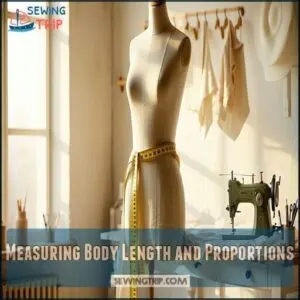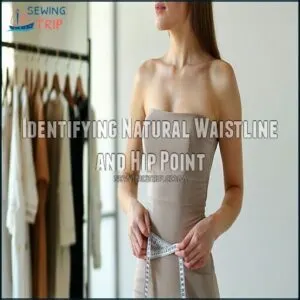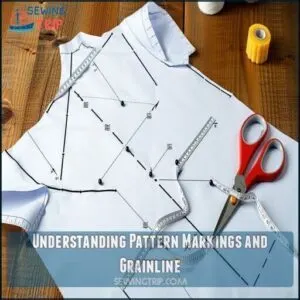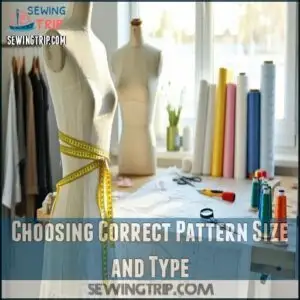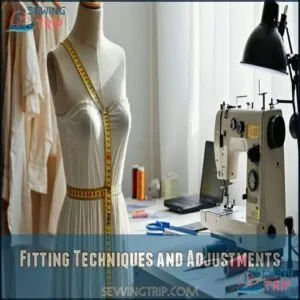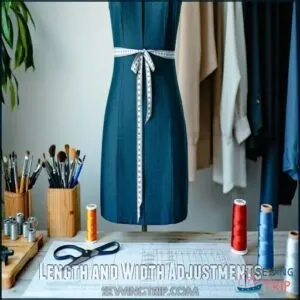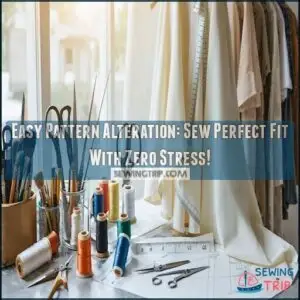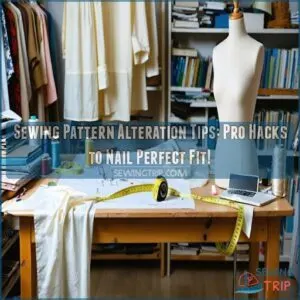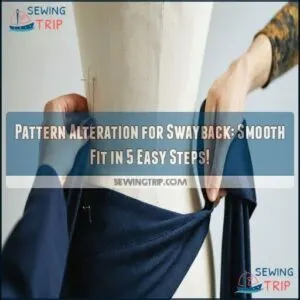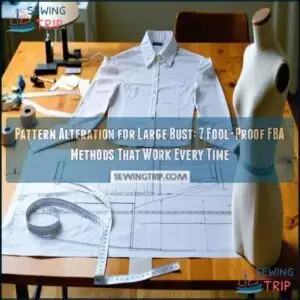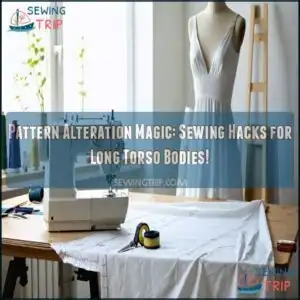This site is supported by our readers. We may earn a commission, at no cost to you, if you purchase through links.
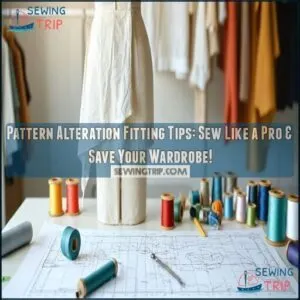
Start by comparing your body measurements to the pattern size chart—this is your roadmap to a perfect fit. You’ll want to trace your pattern onto pattern paper, preserving the original for future use.
Focus on key areas like bust, waist, and hip adjustments. Make test versions using muslin to catch fitting issues before cutting your final fabric.
Remember, small tweaks can make a big difference: adding a dart here, adjusting a seam there. Think of pattern alteration like tailoring a suit—precision is your best friend.
Mastering these skills opens up a world of custom-fit possibilities.
Table Of Contents
Key Takeaways
- You’ll transform your sewing game by meticulously measuring your body and comparing those measurements to pattern size charts, ensuring a custom fit that flatters your unique shape.
- Don’t be afraid to trace original patterns onto pattern paper and create test muslins, which let you catch and adjust fitting issues before cutting into your final fabric.
- Master the art of strategic alterations by focusing on key body areas like bust, waist, and hip, using precise techniques like dart manipulation and strategic seam adjustments to create garments that look professionally tailored.
- You’ll improve your pattern modification skills through patient practice, understanding that each alteration is a learning opportunity that brings you closer to creating perfectly fitted, personalized clothing.
Taking Accurate Measurements
Mastering your body measurements is the secret weapon to creating clothes that fit like a dream.
Unlock your body’s unique blueprint and transform sewing from frustration to fabulous custom fits.
So grab a flexible tape measure and get ready to transform your sewing game.
By learning to measure yourself accurately, you’ll discover the power to customize patterns that hug your unique curves and make every garment look professionally crafted.
Measuring Body Length and Proportions
Your body is a unique blueprint waiting to be measured.
Take a flexible tape and measure your torso length from shoulder to desired garment endpoint.
Include arm span and carefully track body proportions.
Consider your full height and torso size to create an accurate body length measurement that’ll transform your sewing projects.
Precision is key in muslin testing.
Identifying Natural Waistline and Hip Point
Find your natural waistline by locating the narrowest part of your torso, typically between your ribs and hip bones.
This key body landmark helps guarantee accurate hip and waist measurements.
Place a thin belt or elastic at this point while standing straight.
Measure the fullest hip point around the widest part of your hips for precise pattern fitting adjustments.
Understanding Pattern Markings and Grainline
A pattern’s grainline roadmap guides your sewing success like a GPS for fabric navigation. Understanding these vital markings guarantees precise alterations and impeccable garment construction.
- Grainline arrows point to fabric’s straight grain
- Pattern symbols decode seamstress secrets
- Marking accuracy transforms amateur sewing into professional craftsmanship
Your fabric’s drape depends on respecting these essential pattern notations. Proper alignment guarantees the garment’s long-term quality.
Pattern Alteration Basics
You’ll transform your sewing projects from frustrating fits to fabulous finishes by mastering pattern alteration basics.
Learn how to trace, modify, and adjust patterns to create garments that look like they were made just for you, using simple tools and techniques that’ll save your wardrobe from the donation pile, and help you achieve fabulous finishes.
Choosing Correct Pattern Size and Type
Right alongside your sewing journey, sizing up your ideal pattern starts with your unique body blueprint.
— Unleash your sewing potential by measuring your body with precision and confidence.
Forget about clothing sizes—focus on precise body measurements instead.
Size blending becomes your secret weapon, helping you nail the perfect fit across bust, waist, and hip.
Understanding pattern ease guarantees comfort and style, transforming your figure type from frustration to fabulous.
Tracing Original Patterns and Preserving Them
Once you’ve nailed your pattern size, protect those precious originals like gold.
Trace your sewing patterns onto sturdy tracing paper, creating a backup that’ll save you headaches down the line.
Use a tracing wheel and clean paper to duplicate every detail, ensuring pattern longevity and the freedom to adjust without destroying your master copy.
Remember to keep in mind adjusting pattern widths for a more customized fit.
Essential Tools for Pattern Alteration
Now that you’ve carefully traced your original pattern, arm yourself with the right sewing toolkit.
Your measuring arsenal should include a flexible tape measure, clear ruler, and mechanical pencil. Add pattern paper, tracing wheel, and Scotch Magic Tape to manipulate designs.
A helpful tool for sewing is the tracing wheel, which is a key element in transforming pattern alterations.
Seam rippers and sharp scissors complete your workspace essentials, transforming pattern alterations from frustrating to fantastic.
Fitting Techniques and Adjustments
You’ll discover the secret to perfectly fitted garments by mastering pattern alterations suited to your unique body shape.
Learn how to transform generic patterns into custom designs that flatter your figure and make every sewing project a success.
Altering Patterns for Body Shape and Proportions
In the midst of pattern alteration, understanding your unique body shape is key to creating perfectly fitted garments.
Here’s how to map your body proportions like a pro:
- Identify your body’s unique curves and angles
- Recognize narrow or broad shoulder variations
- Assess shoulder slope and armhole depth
- Analyze silhouette for curvy or straight figure adjustments
- Consider specialized modifications like Dowager’s hump accommodations
Muslin fitting becomes your blueprint for sewing success.
Making Full Bust and Small Bust Adjustments
When diving into full bust and small bust adjustments (FBA/SBA), your sewing game changes completely.
Understanding cup size differences helps you nail the perfect fit every time.
By comparing upper and full bust measurements, you’ll discover whether you need an FBA or SBA.
Many sewists find success using specialized sewing patterns.
These precise bodice block modifications transform sewing patterns from generic to genuinely personalized garments.
Modifying Patterns for Shoulder and Armhole Fit
After perfecting your bust adjustments, it’s time to tackle shoulder and armhole fit.
Measure your shoulder slope carefully, noting whether you’ve got broad or round shoulders.
Tiny tweaks in armhole depth can transform your garment’s comfort.
Sleeve adjustments aren’t rocket science—they’re about understanding your unique body shape and making precise pattern modifications that give you a custom-like fit.
Length and Width Adjustments
You’ll save hours of frustration and countless ruined projects by mastering length and width pattern adjustments.
With the right techniques, you’ll transform ill-fitting patterns into garments that hug your curves perfectly and make you feel like a sewing superstar.
Adjusting Pattern Lengths and Hemlines
After perfecting your shoulder and armhole fit, it’s time to master hemline magic.
Measure your body length carefully, considering fabric drape and pattern balance.
Mark inseams and hemlines precisely, measuring from shoulder to desired endpoint.
Adjust pattern lengths using dedicated "lengthen or shorten" lines, ensuring smooth modifications that respect your unique body proportions and allowing for a perfect fit.
Altering Widths and Adding Darts for Shaping
Seam allowances aren’t just extra fabric—they’re your secret weapon for width changes.
Master dart placement by pinning fabric to reveal natural body curves, then strategically adjust your pattern.
Fabric easing techniques help you blend sizes seamlessly while maintaining pattern integrity.
Darts are essential for shaping garments, and understanding dart anatomy helps to achieve a better fit.
With dart manipulation, you’ll transform flat patterns into perfectly contoured garments that hug your unique shape, using dart placement and fabric easing to create a great fit.
Modifying Sleeves and Pant Legs for Fit
With a keen eye for detail, you’ll master sleeve and pant leg modifications like a pro.
Tailor your garments by:
- Measuring from shoulder to wrist
- Checking inseam and leg width
- Pinning for precise hem adjustments
Sleeve alterations transform baggy arms, while strategic pant fitting eliminates bunching.
Adjust crotch depth and sleeve length to create garments that move with your body’s unique contours, allowing for precise hem adjustments.
Advanced Alteration Techniques
You’ve conquered basic pattern alterations and now you’re ready to level up your sewing skills with advanced techniques.
These pro-level methods will transform your pattern adjustments from good to great, helping you create perfectly fitted garments that look like they were made just for you, using complete concepts to achieve this goal.
Mastering Dart Manipulation and Slash and Spread
Transforming dart placement becomes an art when you master slash and spread techniques.
You’ll reshape garments by strategically cutting and spreading pattern pieces, adding volume or adjusting fabric contours.
Use muslin testing to perfect your dart manipulation, ensuring pattern integrity.
Explore specialized tools for darting to enhance precision.
With precise cuts and careful spreading, you’ll create custom-fit designs that hug your body’s unique curves.
Troubleshooting Common Fitting Issues and Errors
Mastering dart manipulation sets the stage for conquering fit challenges. When facing draglines or gaping necklines, start by analyzing horizontal wrinkles and vertical folds in your muslin.
Check shoulder seams, neckline alignment, and bust areas. Don’t guess—measure carefully and make incremental adjustments.
Test each change, noting how diagonal lines shift. Understanding adequate wearing ease is essential for a comfortable fit.
Your patience transforms fitting issues into a perfectly crafted garment, and mastering these skills is key to success.
Frequently Asked Questions (FAQs)
How can I fix uneven hem after alterations?
Measure twice, mark carefully!
When your hem looks lopsided, use a long mirror and mark an even line with chalk.
Pin, press, and trim excess fabric gradually, checking symmetry from multiple angles to guarantee a level, professional finish, ensuring a professional look.
What causes fabric bunching during pattern modifications?
Fabric bunching occurs when you don’t maintain proper grain alignment, use incorrect seam techniques, or fail to ease fabric during alterations.
Uneven tension, poor pinning, and rushed modifications can cause unwanted fabric rippling and distortion.
Can I adjust patterns without sewing experience?
Like a compass guiding lost travelers, beginners can navigate pattern adjustments with patience and practice.
Start with simple modifications, study online tutorials, and don’t fear mistakes—they’re your best teachers on this creative sewing journey, where mistakes are invaluable learning opportunities.
How do professional tailors handle complex alterations?
Pros tackle complex alterations by creating precise muslin mock-ups, using strategic slashing and spreading techniques.
Painstakingly pinning and adjusting seams, and testing each modification to achieve a perfect, personalized garment fit, are crucial steps in the process, which involves painstakingly adjusting to ensure the best outcome.
When should I start over with a pattern?
You’ll want to start over when multiple alterations compromise the pattern’s original design.
Pattern integrity becomes too distorted, or your muslin mock-up reveals extensive fitting challenges that can’t be easily resolved, which is a clear indication to start over when multiple alterations compromise the original intent.
Conclusion
Simply put, mastering pattern alteration fitting tips isn’t rocket science—it’s about understanding your body and letting creativity flow.
You’ll transform frustrating sewing projects into perfectly customized garments by practicing precise measurements and strategic adjustments.
With patience and practice, you’ll confidently modify patterns to match your unique shape, and don’t be afraid to experiment; each alteration brings you closer to wardrobe magic that fits like a glove.
Sew on, fashion friends!

